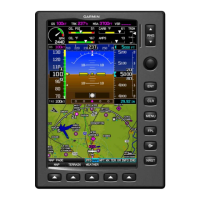Garmin G300 Pilot’s Guide
190-00921-00 Rev. D
34
System Overview
System
Overview
Flight
InstrumentsEIS
COM
Interface
GPS
Navigation
Flight
Planning
Hazard
Avoidance
Additional
Features
Integrated
AutopilotAnnun/AlertsAppendixIndex
ACQUIRING SATELLITES
When the receiver is in the process of acquiring enough satellite signals for
navigation, the receiver uses satellite orbital data (collected continuously from the
satellites) and last known position to determine the satellites that should be in
view. “Acquiring Satellites” is indicated as the solution until a sufficient number
of satellites have been acquired for computing a solution.
When the receiver is in the process of acquiring a 3D differential GPS solution,
“3D GPS Location” is indicated as the solution until the 3D differential fix has
finished acquisition.
SATELLITE INFORMATION
Satellites currently in view are shown at their respective positions on a satellite
constellation diagram. The outer circle of the constellation diagram represents the
horizon, the inner circle represents 45° above the horizon, and the center point
shows the position directly overhead. Each satellite is represented by a square
containing the Pseudo-Random Noise (PRN) number (i.e., satellite identification
number).
The INFO Page can be helpful in troubleshooting weak (or missing) signal levels
due to poor satellite coverage or installation problems. As the GPS receiver locks
onto satellites, a signal strength bar is displayed for each satellite in view, with the
appropriate satellite PRN number (01-32 or 33-64 for WAAS) below each bar. The
progress of satellite acquisition is shown in three stages, as indicated by signal
bar appearance:
- No bar—Receiver is looking for the indicated satellite
- Gray bar—Receiver has collected the necessary data and the satellite signal
can be used
- Green bar—Satellite is being used for the GPS solution

